Valley of Flowers and Hemkunt Sahib

Our planned itinerary
Day 0 - Delhi to Rishikesh (220 km /6 hours) - overnight bus
Day 1 - Rishikesh to Badrinath (300 km / 12 hours) - bus/sumo
Day 2 - Badrinath Darshan - ride to Govindghat (25 km) - trek to Ghanghria (14km / 4-5 hours)
Day 3 - round trek to Hemkunt Sahib(6km + 6km) - night stay at Ghanghria
Day 4 - Valley of Flowers ( 4 + 4 km + as far as you go inside) - trek down to Govindghat.
Day 5 - early morning bus/sumo till Rishikesh - bus ride back to delhi
What we ended up doing
Day 0 - Delhi to Rishikesh (220 km /6 hours) - overnight bus
Day 1 - Sleeping at Rishikesh - waiting for landslide to be cleared
Day 2 - Rishikesh to GovindGhat (280 km) - landslide before Badrinath
Day 3 - trek to Ghanghria (14km) - round trek to Hemkunt Sahib(6km + 6km)
Day 4 - Valley of Flowers ( 6 + 6 km) - trek down to Govindghat.
Day 5 - sumo till Rishikesh, drove around landslide at karnprayag - bus ride back to delhi
Useful information
We carried a tent with us but didn't find much use for it. Camping is not allowed inside valley of flowers and no good camping site between ghanghria and the valley. Staying is not permitted at Hemkunt Sahib. Only good camping spot are a kilometer before ghanghria around the helipad. Tents, sleeping bags, mats and other camping gear are also available at rent at Govindghat.
Trek to Hemkunt Sahib is very steep and tiring. Night stay is not permitted. Try to start early morning so that you are able to come back on time. We did the Hemkunt Sahib trek on the same day as Ghanghria trek but it was really grueling. If weather is bad, it might get very cold at Hemkunt, so carry sufficient woolens. My advice would be to avoid taking steps and stick to the trek.
Valley of flower trek is pretty gentle. Nothing is available inside, so its a good idea to pack a small picnic basket. Please don't leave any garbage or plastic behind. You can explore as deep as you like but stick to the trail. After a couple of kilometers the trail becomes very thin. Its worth the effort to go upto legge's grave.
Buses/sumo/qualis ply between Govindghat and Rishikesh. Buses have to be booked the previous night. There is a time based unidirectional flow of traffic between Joshimath and Badrinath. The first gate at Govindghat opens at 7:50 am. So if you want to start earlier, you might consider reaching Joshimath the previous night. Travel is not allowed after dark on the Badrinath highway.
Thursday, 2nd Aug, 7:00 pm
I am sitting in a small room of Shiva resort at Rishikesh, some 400 meters from Ram Jhula. The room is comfortable and the resort is open and green. Coming from an expensive place like Delhi, the room is a good bargain at 300 Rs. Its not the worst place to be spending a day in. About 5 minutes walk away, the Holy Ganges is flowing in full monsoon glory. In the morning, when I laid eyes on the fierce flow of the muddy water, I was awed. The fury of the water had submerged the banks and the ghats, and it was wider than I have ever seen at Risihikesh. A layer of mist had formed on the surface making the water level appear a lot higher than it actually was. Curving and bending it seemed like a giant anaconda ready to swallow whatever comes in its path. This however, did nothing to deter the faith of the devotees, who come to take a dip in the holy water and wash away their sins. This was also the month of Sawan, and millions of kawarias flock the city from far off places to fetch the holy water to the temples in their villages and cities. Dressed in saffron, Bhole-Bhole on their tongue, they would walk several 100 kilometers, carrying the Gangajal on a balance pole (kawar).
I had not planned to stay in this room, or in this city. 22 hours earlier, when I and my companion Pratyush(PK) had boarded a bus to Rishikesh, I had only one thing on my mind - Valley of flowers. The bus was rattling everywhere, the seats rather uncomfortable, and the air was choked with the smoke of bidis that everyone including the bus driver and conductor puffed on, blatantly ignoring the no-smoking sign painted on the front. I took comfort in the fact that each minute in the bus was taking me closer to the place, I had planned on visiting for the last two years. Reaching Hardwar around 5 am, we had quickly got ourselves on a bus to Badrinath. We had intended to visit the Badrinath temple with the first light of the next day, catch a bus to Govindghat and start the 14 km trek for Ghangaria, which is 4 km from the valley. No sooner had we started to get ourselves settled for the 12 hour ride, we were stopped by police and informed that the highway is closed due to a landslide. No one knew when the road would be cleared.
We have spent most of the day, sleeping. The disappointment of the break in journey have filled us with a strange lethargy. Neither the temptation of a refreshing dip nor the promise of a place in heaven, have been able to drag us to the ghats of the Holy Ganga. We just went out on a reconnaissance mission to check out the bus-stops and the bus timings to Badrinath. What we don't know is whether the route will be cleared up for the following morning. It is our only chance, for we could not afford to wait another day. Before starting we had been warned about the landslides and kawarias. We were prepared for small delays and discomforts. But we were not prepared to turn back. Yet now we could only pray and hope that this is precisely not what we would be forced to do, the next morning. It all rests on fate....
Friday, 3rd Aug, 10:00 pm

We have reached Govindghat, checked into a hotel after a light dinner and are preparing for bed. It was a long journey but filled with most breathtaking views. The roa
 d twists and turns continuously amidst a background of green mountains. Ganges flows parallel to the road, sometimes nearby, sometimes deep down in the valley, but never out of sight. The path is often crossed by small streams, that flows down from some secret location in the mountains and join the river below. I have been on this route several times but I can never get tired of the abundance of beauty that is sprawled in each corner.
d twists and turns continuously amidst a background of green mountains. Ganges flows parallel to the road, sometimes nearby, sometimes deep down in the valley, but never out of sight. The path is often crossed by small streams, that flows down from some secret location in the mountains and join the river below. I have been on this route several times but I can never get tired of the abundance of beauty that is sprawled in each corner.Our day started early at 4am. We woke up the manager to pay for the room, but only after we made him promise that he would take us in if we come back an hour later. It was still dark outside when we stepped out of the resort. Ram Jhula was a sharp contrast to the madness of the day. The faceless crowd had been replaced by a handful of devotes taking a dip. Bright yellow lights were getting reflected in the blackness of the water. There was a slight drizzle in the air. It wa
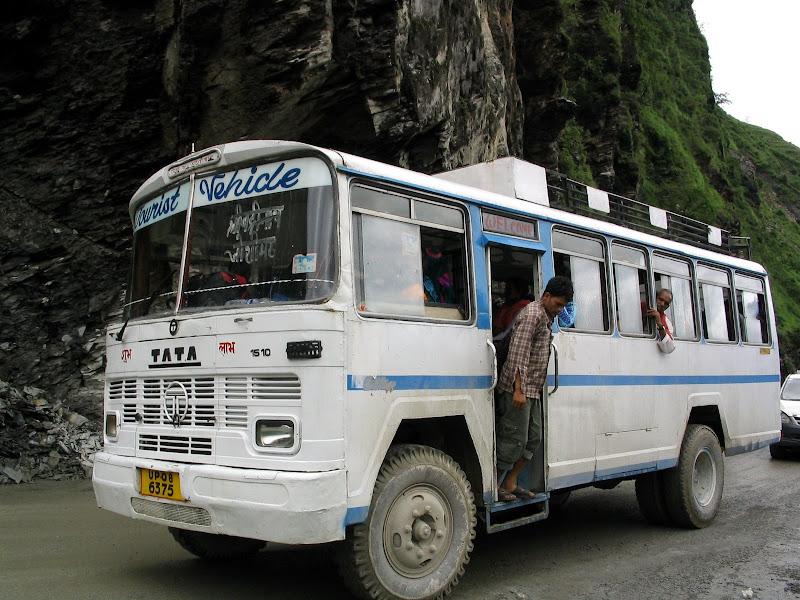 s serene and inviting but we had no time to waste. Hitching a ride with a group of kawarias, and walking the remaining 1.5 kilometers to the Tehri Bus stand, we reached almost too early. As we handed the ticket money, we were afraid it would be refunded an hour later. By now it was raining quite heavily.
s serene and inviting but we had no time to waste. Hitching a ride with a group of kawarias, and walking the remaining 1.5 kilometers to the Tehri Bus stand, we reached almost too early. As we handed the ticket money, we were afraid it would be refunded an hour later. By now it was raining quite heavily.The bus started 45 minutes later, stopping to pick pre-booked passengers on the way, each stop adding to our anxiety. The highway had been turned into a dumping ground of debris by the frequent landslides. The pile of huge rocks stacked up on the sides of the road, made us appreciate why it could take so long to clear the block. Crossing the point where we had been stopped the previous morning was the first good sign, but it wasn't before another 50 kilometers that we finally relaxed. Yes, we are on our way..
First came Srinagar, followed by Devprayag, Karanpray
 ag, Nandprayag and Rudraprayag. After 6 hours of drive, we were almost halfway there. A welcome break at Pipalkoti for lunch and we were on our seats again. The relentless journey was finally broken up at Joshimath. There had been another landslide near Badrinath and our bus would not go any further. "Way to Govindghat is still open" and that's where we decided to spend the night. A quick change of bus got us to Govindghat, a small settlement on the banks of Hem Ganga, serving mainly as the road base for Hemkunt Sahib and Valley of flowers trek. Govindghat is made up of a Gurudwara, some small hotels and a row of small shops mostly selling prasad and religious stuff. On the bus we made friends with a couple of tour operators who are now sharing the four bed room with us.
ag, Nandprayag and Rudraprayag. After 6 hours of drive, we were almost halfway there. A welcome break at Pipalkoti for lunch and we were on our seats again. The relentless journey was finally broken up at Joshimath. There had been another landslide near Badrinath and our bus would not go any further. "Way to Govindghat is still open" and that's where we decided to spend the night. A quick change of bus got us to Govindghat, a small settlement on the banks of Hem Ganga, serving mainly as the road base for Hemkunt Sahib and Valley of flowers trek. Govindghat is made up of a Gurudwara, some small hotels and a row of small shops mostly selling prasad and religious stuff. On the bus we made friends with a couple of tour operators who are now sharing the four bed room with us.Everyone else except me has gone to sleep. It has been a long day and we would again start early the next morning. A little while back, we had decided that we would not be able to carry all of 24 kg luggage during the trek. After some discussion we left behind the tent, all the camping gear, extra clothing, and managed to get down the load to half. Leaving behind stuff is like cleaning up disk space on your computer. You are not sure if you are going to need a certain file but you don't want to delete it just in case you do. My eyes are getting heavier now and I should get some rest as well. Hope we have a clear weather tomorrow...
Saturday, 4th Aug, 8:00 pm
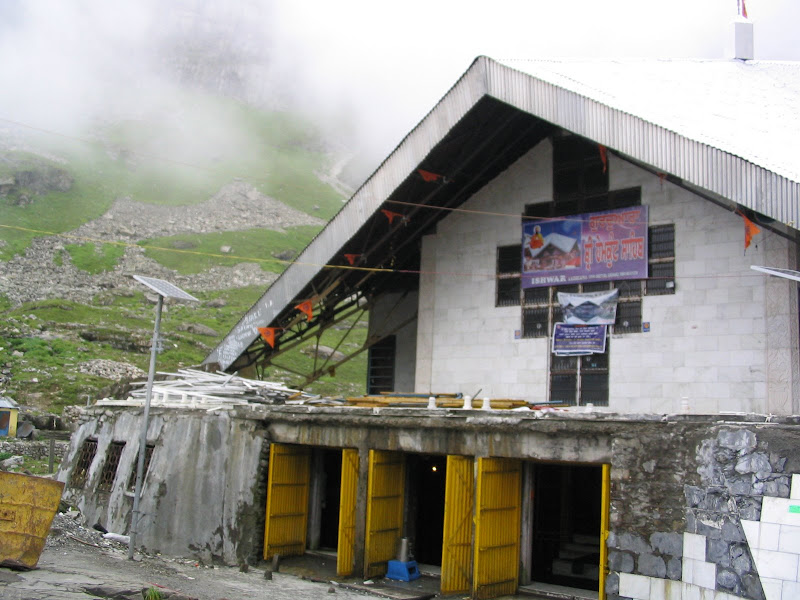
My legs hurt, my shoulders hurt and my back hurts worst of all. I have spent the last hour in bed. Pk is spread out in a similar condition on the adjacent bed. He hasn't moved for a long time but I think he is still alive. Both of us have already taken a double dose of paracetamol. My belly is demanding re-fueling after all the energy I have spent, but I don't feel like getting out of bed. I wish I was at home eating pooris out of my mom's hands. But I am 25 hours from home, in a dormitory of the GMVN guest-house at Ghangaria. It has been a grueling day, with 14 km trek to Ghangaria, and 12 km tough, tough, tough return trip to Hemkunt Sahib. If I ever have been more tired in my life, I just don't remember it.
After 3km, we crossed a small village. The bag was proving to be a bit heavier than I would like but every so often a passerby would remark "itna bada bag leke chad rahe ho" and that would bring a spring to my step - oh what an ego. Finally it stopped raining after a couple of hours. I quickly split the bag in two and handed the heavier one to pk. Mid way we stopped for a cup of tea and maggi. While paying I was shocked to be charged 80 bucks. Everything was being sold for double the price and afterwards we were careful not to order anything without asking the price first.
Pk on move is a perfect example of a tortoise. He would walk at a leisurely pace, sometimes even bordering on painfully slow. But he is sure to beat the hare with his persistence, for he would continue to walk kilometer after kilometer without ever stopping for a breath. On the entire 28 km (both-ways) between Govindghat and Ghangaria, he stopped not more than twice. I prefer to go a little faster, so I would build up a lead, find myself a nice spot, and wait for pk to pass me while I enjoyed the scenery.
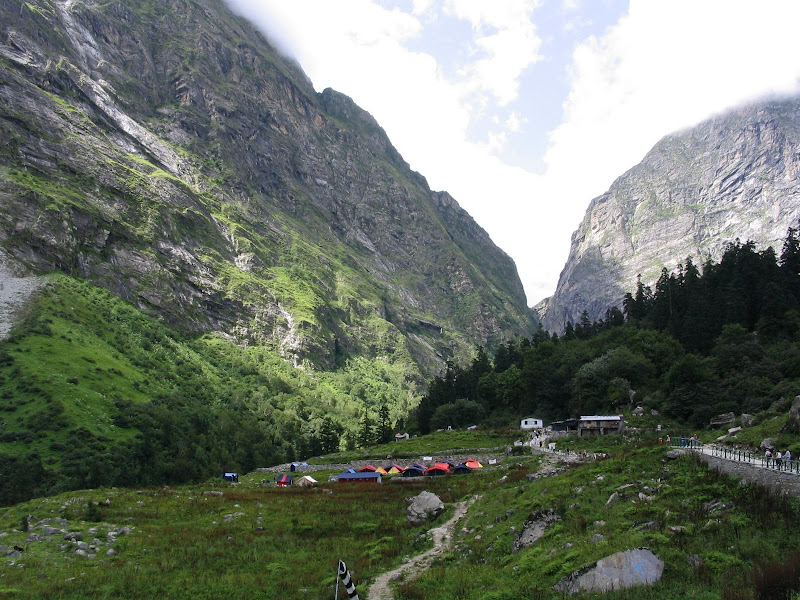 The later part of the trek had a lot more signs of landslide activity. The climb got a bit steeper at the end and we were exhausted by the time we reached Ghangaria. Just before Ghangaria there is a helipad and a beautiful camping site. Ghangaria itself, is a long row of hotels and shops, on both sides of a muddy road. We quickly checked into the GMVN dorm at 150 Rs per bed. The rooms were a bit pricey at 750 Rs. The dorm had 5 double-storeyed beds but none were occupied. After a quick lunch, we started for the valley of flowers. It was 12:00 pm by now and was raining again.
The later part of the trek had a lot more signs of landslide activity. The climb got a bit steeper at the end and we were exhausted by the time we reached Ghangaria. Just before Ghangaria there is a helipad and a beautiful camping site. Ghangaria itself, is a long row of hotels and shops, on both sides of a muddy road. We quickly checked into the GMVN dorm at 150 Rs per bed. The rooms were a bit pricey at 750 Rs. The dorm had 5 double-storeyed beds but none were occupied. After a quick lunch, we started for the valley of flowers. It was 12:00 pm by now and was raining again.There is a common path out of Ghangaria that forks into two after a kilometer. The straight road continues to Hemkunt Sahib while the one on the left takes you to the valley of flowers. We decided that we won't be able to enjoy the valley in such weather and would rather go to
 Hemkunt Sahib. The trek to Hemkunt Sahib is so steep that you gain an altitude of 1.3 km over a distance of 6 km. The rains made it humid and we were sweating in our raincoats as we climbed. Very quickly we gained a decent height and could see Ghangaria much below us. I took the first opportunity to get rid of the raincoat and did the rest of the trek with a gentle drizzle against my face. Looking back it was much pleasant to do the trek in a cooling shower than to have the sun beating down on us.
Hemkunt Sahib. The trek to Hemkunt Sahib is so steep that you gain an altitude of 1.3 km over a distance of 6 km. The rains made it humid and we were sweating in our raincoats as we climbed. Very quickly we gained a decent height and could see Ghangaria much below us. I took the first opportunity to get rid of the raincoat and did the rest of the trek with a gentle drizzle against my face. Looking back it was much pleasant to do the trek in a cooling shower than to have the sun beating down on us.The trek to Hemkunt Sahib is up the face of the mountain. Looking down we had wonderful views of the valley and the mountains on the opposite side. One look up and we couldn't believe how much we have yet to climb. By now we had been walking for 3 hours. Combined with the 14 km trek to Ghangaria, we were dead tired and our progress was slow
A little later we hit a point where you had an option of taking steps. Standing on the foot of the steps, I could only see them disappear behind the clouds. With no idea of how many there were, we took the steps anyway, to save time. By now I was running on reserve and Pk almost out of gas. Steps didn't prove too kind on his knees and he started to stop for rest every 5 minutes. I was not enjoying them either, but I did my best to encourage him to keep going. By now, we couldn't see any other soul around us. Pk suggested that we should go back but I said its not the Everest that we are climbing. The news of a few people dying at Hemkunt Sahib due to cold was still fresh in our minds. Suddenly I saw a Sardarji climbing the steps behind us. I don't think I have ever been happier to see a Sardar in my life. It was such a relief to know that you are not the only two fools left on earth. So the three fools started climbing again.
Everytime we would feel that this must be the last 100 steps, only to get there and find another set of steps. We kept climbing and then at last there were no more steps - we had
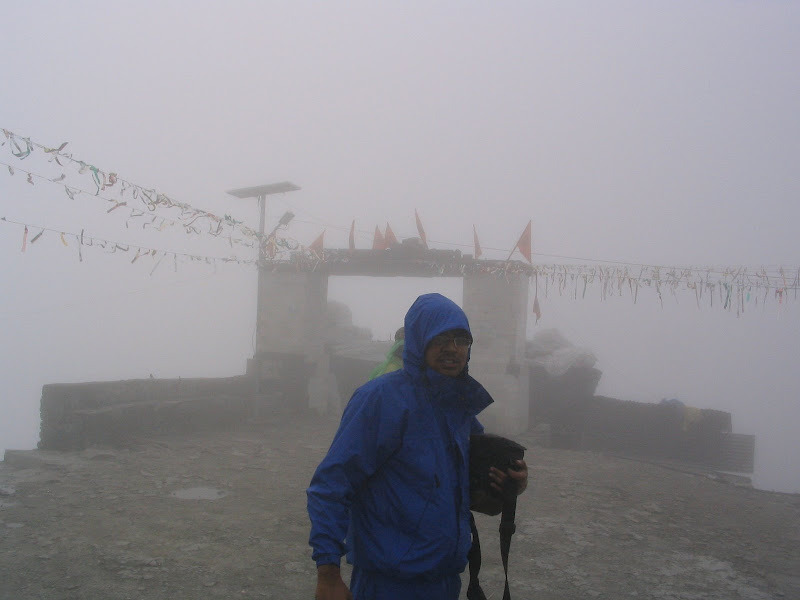 reached the top. By the time we reached it was 4 pm and so foggy we couldn't see much of anything. A sign board in the middle of a huge empty space declared that there was a lake there, somewhere. Suddenly a Sardarji in a dark blue knee length skirt and a yellow turban with a dagger hanging by his side, came shouting at us - "tusi hun ki kar rahe ho". I guess he was surprised to find us there at that late hour. He declared that there is no place to stay at Hemkunt Sahib and we must go down immediately. When we told him that we are coming from Govindghat and dead tired, he turned a bit kinder. He asked us to take a dip in the lake and come for Langar. One hand in the icy cold water convinced us we were not going inside. We were not carrying towels or clothes anyway. So we just washed our hands and faces, and went in the hall. We were served some khichdi and hot tea.
reached the top. By the time we reached it was 4 pm and so foggy we couldn't see much of anything. A sign board in the middle of a huge empty space declared that there was a lake there, somewhere. Suddenly a Sardarji in a dark blue knee length skirt and a yellow turban with a dagger hanging by his side, came shouting at us - "tusi hun ki kar rahe ho". I guess he was surprised to find us there at that late hour. He declared that there is no place to stay at Hemkunt Sahib and we must go down immediately. When we told him that we are coming from Govindghat and dead tired, he turned a bit kinder. He asked us to take a dip in the lake and come for Langar. One hand in the icy cold water convinced us we were not going inside. We were not carrying towels or clothes anyway. So we just washed our hands and faces, and went in the hall. We were served some khichdi and hot tea.Now, I generally don't believe in miracles but what happened in those 30 minutes was nothing sort of one. When we sat down for the Langar, we w
 ere totally exhausted. The weather outside continued to be bad. It was getting darker and threating to rain anytime. We realized that if it started raining we would be in real trouble. But as I had one spoonful of khichdi, after another, I was abruptly filled with a feeling of goodness. Sipping on the cup of tea, all tiredness evaporated out of my body. I felt like I had been reborn, full of energy. Pk was also beginning to grin in a way that comes so naturally to him, when he is in a good mood. We came out to find the sun shining brightly. All the clouds had gone into a hiding somewhere. It was now, the beauty of the place hit us. The structure of the Gurudwara standing against the background of mountains. The clear water of the lake reflecting the green and brown of the surroundings. The stillness and quite around us. We were no longer in any hurry. We sat about taking pictures of the lake. Going down 6 km no longer seemed much of an issue - hell we felt like we could climb right up. We felt blessed by the pleasant sun rays. It was finally the same Sardarji who drove us out of the place saying it was getting late.
ere totally exhausted. The weather outside continued to be bad. It was getting darker and threating to rain anytime. We realized that if it started raining we would be in real trouble. But as I had one spoonful of khichdi, after another, I was abruptly filled with a feeling of goodness. Sipping on the cup of tea, all tiredness evaporated out of my body. I felt like I had been reborn, full of energy. Pk was also beginning to grin in a way that comes so naturally to him, when he is in a good mood. We came out to find the sun shining brightly. All the clouds had gone into a hiding somewhere. It was now, the beauty of the place hit us. The structure of the Gurudwara standing against the background of mountains. The clear water of the lake reflecting the green and brown of the surroundings. The stillness and quite around us. We were no longer in any hurry. We sat about taking pictures of the lake. Going down 6 km no longer seemed much of an issue - hell we felt like we could climb right up. We felt blessed by the pleasant sun rays. It was finally the same Sardarji who drove us out of the place saying it was getting late.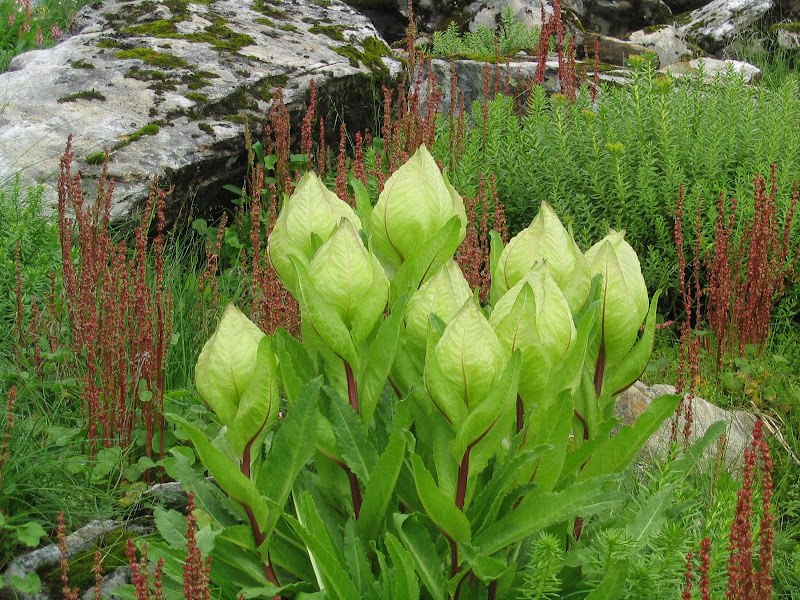 We almost raced down. The steep slope that had killed us while going up, now gave us wings. It felt wonderful to be out on the trek alone - without the usual rush of people and mules. On the way down, I spotted several different flowers and among them Brahmakamals. After getting some nice shots, we continued to speed down. Within an hour, we could see Ghangharia below us. The sun was beginning to set now but there was fair amount of light. No longer afraid of getting stuck midway, we sat down on a large rock to soak in the scenery around us. We sat there for a long time, till the light begin to fade. This time we walked slowly, with none of the previous urgency or energy. It had been a long tiring day. We had been up for more than 12 hours and had spent most of it walking. It took longer to get down than we had expected, but we were not in any hurry. As our bodies cooled down, it started to hurt everywhere. We were reduced to a bundle of aching muscles. Somehow we found our beds and crashed.
We almost raced down. The steep slope that had killed us while going up, now gave us wings. It felt wonderful to be out on the trek alone - without the usual rush of people and mules. On the way down, I spotted several different flowers and among them Brahmakamals. After getting some nice shots, we continued to speed down. Within an hour, we could see Ghangharia below us. The sun was beginning to set now but there was fair amount of light. No longer afraid of getting stuck midway, we sat down on a large rock to soak in the scenery around us. We sat there for a long time, till the light begin to fade. This time we walked slowly, with none of the previous urgency or energy. It had been a long tiring day. We had been up for more than 12 hours and had spent most of it walking. It took longer to get down than we had expected, but we were not in any hurry. As our bodies cooled down, it started to hurt everywhere. We were reduced to a bundle of aching muscles. Somehow we found our beds and crashed.Thats where I have been lying for the last hour. A few times it crossed my mind if we would be able to walk to the valley of flowers tomorrow. But I already know the answer to that. In truth, I am feeling a little disappointed in myself. It had been a tough day but I didn't expect my body to betray me like this, to be in such agony. But I know it will bounce right back tomorrow, ready for another adventure, another day of walking. All it need is a good meal and a night of sound sleep, and I am sure we are going to sleep like logs tonight....
Sunday, 5th August, 11 am
"In all my mountain wandering, I have not seen a more beautiful valley where the human spirit may find repose"
- Frank Smythe
I am in heaven. No I haven't died, I am more alive than ever before. I am lying on a thick carpet of grass, adorned with several different floral patterns. The sky is clear blue with a few white clouds playing around. A cool breeze is blowing, making the flowers dance to its tune. The sun is shining brightly. It was getting into my eyes a bit when a little cloud floated across to cover it. "Everything is going to be perfect for you today", it seems to be saying with a slight grin on its face. Honey bees are flying around me, playing with the delicate flowers. Sometimes they come and sit on me. I let them without any protest or resistance. I am sure they have no reason to sting me. They know, that although I have encroached upon their land, I mean no harm to them or to their flowers. The carpet of grass and flowers extend through out the valley, continuing up the slope of the mountains that bound the valley on two sides. Small streams are flowing down the mountain, right across the valley, into the HemGanga below. At the far end of the valley, a snow covered peak is hiding behind a lonely cloud.
This is the Valley of Flowers, home to over 300 species of wild flowers, a World Heritage site. I am near the grave of Joan Margaret Legge, a botanist who fell to her death here in 1939. "I will lift mine eyes unto the Hills from whence cometh my strength" reads the gravestone. 15 minutes earlier, Pk and I were sitting beside the grave. Now I am alone. No, he has not been taken by her ghost. He is walking back, but I stayed for a little longer. I wanted to be alone amidst all this beauty. I know I need to get going now, otherwise Pk would wait for me and get worried. But its proving difficult to leave. All I want to do is to just keep lying here....
 I woke up in the morning to find a crystal clear sky. This was certainly different from the previous 3 days. "Its a lovely weather for the Valley" remarked the GMVN attendant. Looks like our decision of going to Hemkunt Sahib yesterday, is going to be a good one. GMVN guys have been really good to us - very hospitable and friendly. After preparing a breakfast of aaloo paranthas, they also packed us a couple of sandwiches for the Valley.
I woke up in the morning to find a crystal clear sky. This was certainly different from the previous 3 days. "Its a lovely weather for the Valley" remarked the GMVN attendant. Looks like our decision of going to Hemkunt Sahib yesterday, is going to be a good one. GMVN guys have been really good to us - very hospitable and friendly. After preparing a breakfast of aaloo paranthas, they also packed us a couple of sandwiches for the Valley.There was a rush of Sikh pilgrims, but surprisingly not even one of them turned towards the Valley. A small check post at the entrance displayed a map of the area and a list of some of the more commonly found species of flowers. We found ourselves walking through a beautiful forest. Already there were several different species of flowers on both sides of the trail. I began clicking my digicam like crazy, while Pk held onto his role for later.
The Valley starts after 3 km from the check post. Its a mild trek and you gain an altitude of nearly 500 m. The path goes through a forest, crossing a frozen stream, onto a bridge over the ferocious Hem Ganga, followed by a climb on the other side. The trail was narrow here with flower cover thickening on both sides. As we gained altitude, the forest started giving away. A recent landslide was blocking the way, forcing us to climb over the rock and dirt.
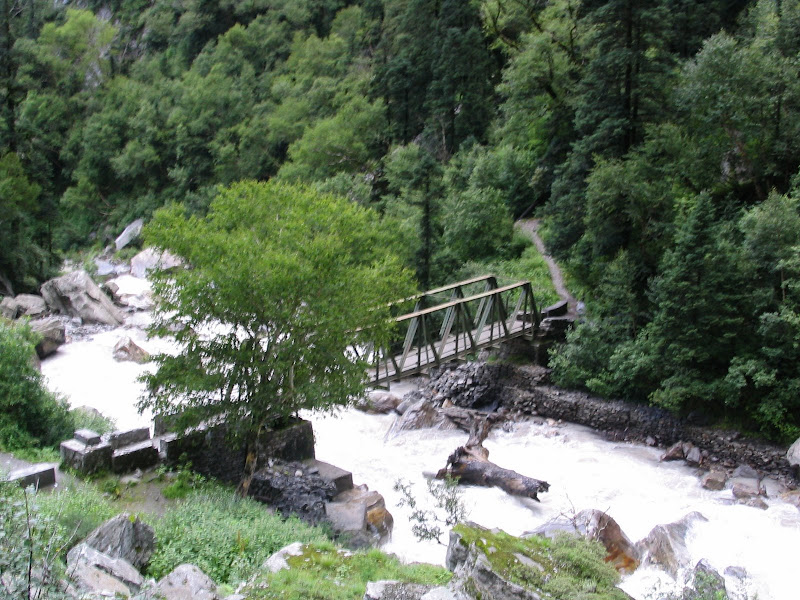
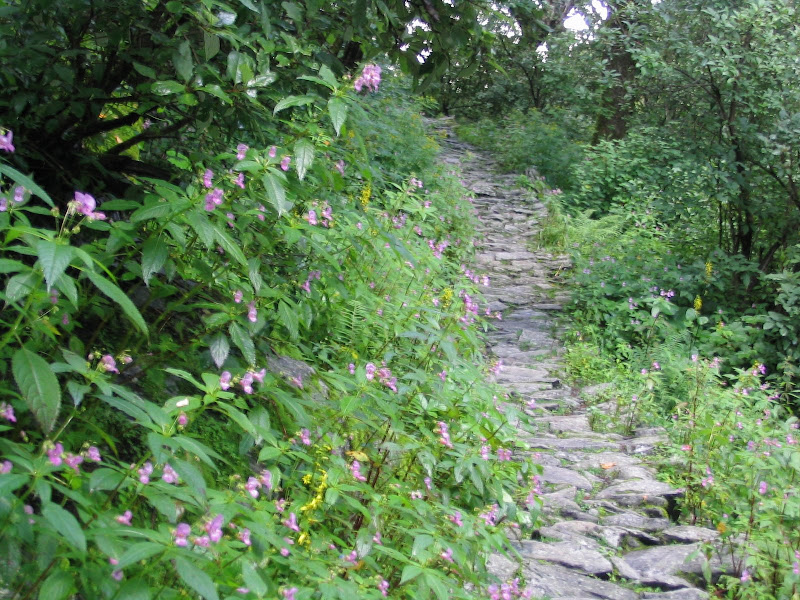
 Eventually the trail leveled out, and we could see the valley a kilometer away. HemGanga was flowing to our right, covered at some places with snow. Opposite us a vertical cliff was rising a few hundred feet. We crossed another frozen stream. 15 minutes later we were into the valley.
Eventually the trail leveled out, and we could see the valley a kilometer away. HemGanga was flowing to our right, covered at some places with snow. Opposite us a vertical cliff was rising a few hundred feet. We crossed another frozen stream. 15 minutes later we were into the valley.
Even from a distance we could make out the purple over the green valley. Now the flowers were everywhere. We were literally walking between flowers. I think its quite useless to say that I had never before seen so many flowers. The flower cover was so thick that we were forced to stick to the narrow trail. "It is so beautiful" - thats the thought that kept repeating in my mind. Now even Pk got his camera out. He had saved his role earnestly for this, and I think it was worth it. Pk was taking my pic, when a Japanese guy offered to shoot both of us. As it turned out this is the only pic of the trip with both of us in it. Talking to him, revealed that he had flown down to India specifically to see the Valley.
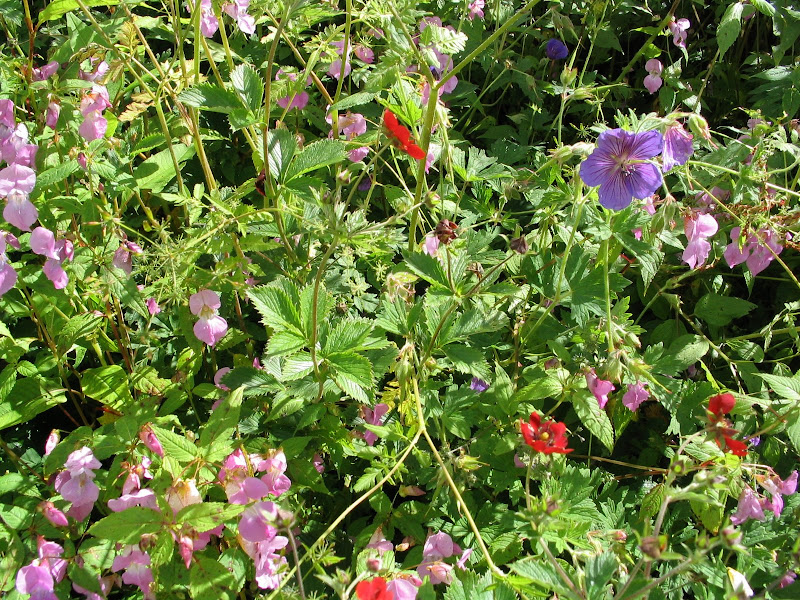
As we were marveling at all the beauty around us, we met three person who made me realize how different perceptions can be. All three of them were from Ludhiana and had come to visit Hemkunt Sahib. Spare time had prompted them to come to the Valley. Now they couldn't understand what the fuss was all about. "There are more flowers in my backyard. Will it get any better further" one of them remarked with a disapproving look. I got angry at their remark. I felt as if they are being critical of something personal to me. I thought that some people can only find beauty in a free langar. I told them that they should not waste their time in going further. I also asked for an invitation to visit their backyard sometime.
Moving on we hit the documentary team from Japan. They were shooting a documentary for a local channel. One of the girls told us that we are really lucky to get such sunny weather. They had been trying to shoot for the past seven days but it just wouldn't stop raining. Only today they had been able to get some work done. Personally, I wouldn't have minded a slight drizzle but rains would have definitely been a big spoilsport.
 Continuing on the trail we reached a small stream. A wooden bridge had been constructed over the stream. We had a drink out of the refreshing cold water and sat down for our sandwiches. After eating, Pk picked out a grass clearing and lied down. We were determined to go as far into the valley as time would allow us. So we moved on even after the trail started to blend into the flowers. Clearly this part was not very frequently visited. We kept moving forward forcing our way through. Every so often, we would spot a species of flower that we hadn't seen earlier.
Continuing on the trail we reached a small stream. A wooden bridge had been constructed over the stream. We had a drink out of the refreshing cold water and sat down for our sandwiches. After eating, Pk picked out a grass clearing and lied down. We were determined to go as far into the valley as time would allow us. So we moved on even after the trail started to blend into the flowers. Clearly this part was not very frequently visited. We kept moving forward forcing our way through. Every so often, we would spot a species of flower that we hadn't seen earlier.We hit another stream, this time without a bridge. A big leap would have taken us across but we sat down at the edge wondering if we should go any further. We would have gone back if we hadn't met a Bengali group who were coming back from Legge's grave. They told us that it was less than a kilometer ahead. A little further the trail forked into two, with the right one turning back towards the grave.
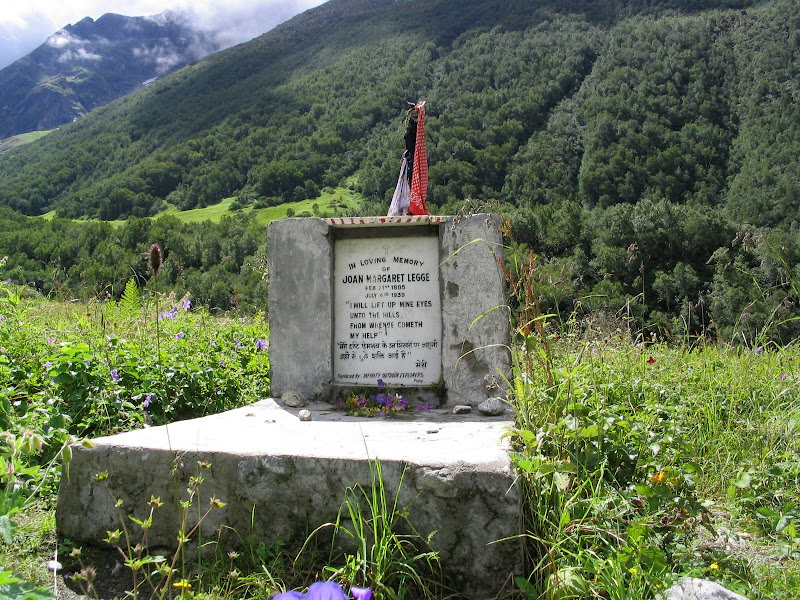 We had been sitting near the grave for half an hour, when Pk left. I had told him that I would follow after 5 minutes but I don't feel like going back. It seems like such a perfect place for an undisturbed reading or sleep. Its such a shame that I can't spend the night here. Its such a shame that I can't stay here longer, probably for a lifetime. But I would go back and what would remain with me are the memories of being at a place whose beauty can't be described with words, whose beauty can't be shown by pictures, whose beauty can only be experienced.
We had been sitting near the grave for half an hour, when Pk left. I had told him that I would follow after 5 minutes but I don't feel like going back. It seems like such a perfect place for an undisturbed reading or sleep. Its such a shame that I can't spend the night here. Its such a shame that I can't stay here longer, probably for a lifetime. But I would go back and what would remain with me are the memories of being at a place whose beauty can't be described with words, whose beauty can't be shown by pictures, whose beauty can only be experienced."You cannot stay on the mountain forever. You have to come down again. So why bother in the first place? Just this: What is above knows what is below, but what is below does not know what is above. One climbs, one sees. One descends, one sees no longer, but one has seen. There is an art of conducting oneself in the lower regions by the memory of what one saw higher.
- Rene Daumel, Mont Analogue
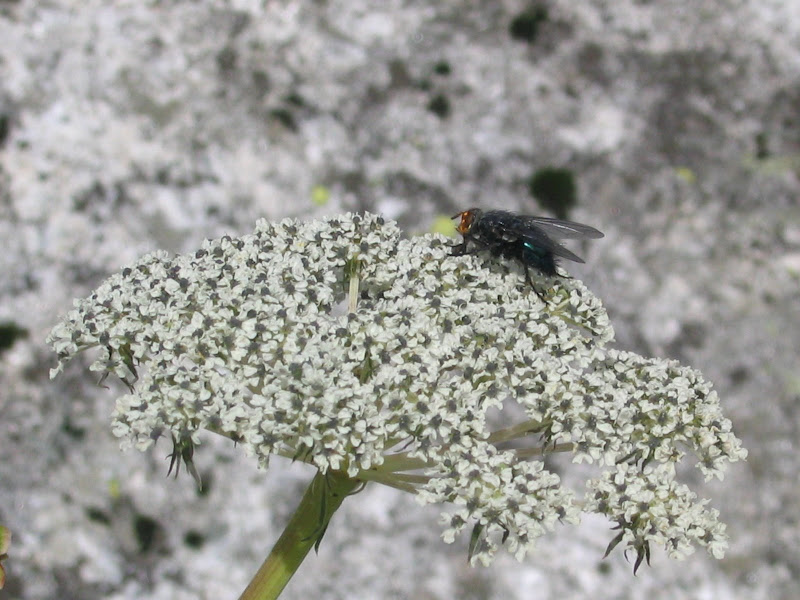

Tuesday, 7th Aug, 1:30 am
According to plan, I should have been home right now, nestled up in my cozy bed. But things have rarely gone to plan on this trip. Instead, I am in the middle of a deserted road, few kilometers before Saharanpur. Our Uttrakhand Parivahan bus is standing a few steps away from us. The driver is trying to crank it up after every five minutes. Initially, I was hoping that it would start any moment and we would be on our way. But after an hour, all of us have given up hope. We are trying to stop some bus going in the right direction. A few minutes ago, a UP Parivan bus sped past our outstretched hands. "Saale UP wale nahi rokenge" came a piece of Gyaan from our driver. Apparently there aren't such good relations between UP Parivahan and Uttrakhand Parivahan. I lift up my head to look at the bright moon in the sky. Its a beautiful night. Still I would rather be home than in the middle of nowhere.
My feelings right now are in exact contrast to the peace I felt in the Valley yesterday. After staying near Legge's grave for almost an hour, I finally made myself to get up and walk back. It was a long solitary walk, one that I wished would never end. It was only after an hour that I saw Pk sitting on a rock beside a stream. There was another family sitting beside him. The family consisted of two adults, two kids and two elders who were traveling on an open doli carried by four porters each. There was a look of exhaustion and disappointment on there faces. The effort was proving too much and their tired souls were unable to see the beauty around them. They were going to turn back just at the edge of the valley. Even later, I have heard so many people remark how the valley wasn't as beautiful as they expected. I am not sure how to react to that. Perhaps, I am a little too easy to please. Perhaps, I am able to find beauty in a lot of things that others ignore. But the fact is that the Valley would remain one of the most beautiful places that I have been to.
After a quick sip from the stream and a gentle splash on the face, we started back. Back at the guest-house, we had a quick lunch, paid our bills and packed our bags. It was already 2:30 pm, but we were hoping to get back by 5, and grab a transport till Joshimath or further. Again didn't turn out the way we planned, and we were only midway by 4:30 pm. We decided to spend the night at Govindghat. By the time we reached Govindghat, we were dead tired and had just enough strength to find a room and crash to our beds. For dinner, we had a packet of biscuits.
Early in the morning, we found a shared Sumo for the ride back. Pk and I occupied the front two seats which offered a lovely view throughout the journey. The middle seats were occupied by two Sikh couples, and the back seats were filled by 4 youths from Ludhiana. The Sumo ride was much interesting than the bus ride coz we had the whole view in front of us. It was also nice to chat to the driver and gather some information about the place. We stopped at Pipalkoti for breakfast and were relieved to know that our Hutch connection was back. Inspite of the PCOs at Govindghat, we had remained disconnected from the world for 3 days now. A quick call to home on the way telling them that we were expected back around midnight. That plan changed soon enough. At Karanprayag, we were told that 5 km further the road is blocked by landslides. No one knew how much time it would take for the road to be cleared. The driver told us that there was an alternate route via Chopta. The detour would take us around the landslide to rejoin the main highway at Rudraprayag but it would cost us an extra 3 hours and 50 bucks each.
I was more worried about the extra 3 hours. It meant we would not be able to reach Delhi before next morning. But still it was better than waiting for the landslide to be cleared which might take another day. I decided to play it cool, forget about plans and enjoy the new ride. However, the Sikh couple had a major fight with the driver over the extra 50 bucks. They insisted that the driver should take them to Rishikesh on the agreed fare. There was a heated argument between them but finally we were able to convince them. So we left the highway and took to the small hilly road. Once I got over the upset schedule, it was actually quite a fun ride. We climbed over the hill driving on a small road through the lovely forests. We stopped near a hand-pump to fill our water bottles. The water was so chilled and refreshing that I couldn't resist splashing it all over my face and hair.
We were in Rudraprayag 3 hours later but still a long way from home. I had given up on any timetable by now and was just trying to enjoy the way. Few hours from Rishikesh, it started raining heavily. The sumo's wipers weren't in the best condition and we were also worried about more landslides. Sardarji in the back started singing some religious songs. I don't understand Punjabi well but he did have a deep resonating voice. It was getting dark by the time we reached Kaudilya, around 30 km from Rishikesh. I thought just an hour to go now but that again was not to be. We ran into two sumos in front. One of them had a totally dead battery and hence no horn, indicators or head light. Everytime the engine shut down, the occupants had to push it for a jump-start. It was decided that we would lead the sumo with our tail lights while the other sumo would light up the road from behind. Wasn't easy synchronizing the speed of all three vehicles in the dark. Our driver had been driving for 12 hours by then, and he was clearly in stress guiding the faulty vehicle. Our procession was slowed down considerably and it was not before 9 pm that we finally reached Rishikesh.
Rishikesh was still flooded by all the kawarians. We quickly got down our luggage and started for the bus stop. All the vikrams that passed us by were already jam packed. Some even had passengers on the roof. We were told that the bus stop was only a kilometer down the road, but we had already walked more. We managed to convince an auto-rikshaw to drop us to the bus stop - at a hefty fees ofcourse. But the moment we landed at the bus stop and saw a deluxe bus ready to depart for Delhi any minute, we felt that the extra fees was worth it. It was a much better bus than the one we had arrived in and we even got two seats in the front. We put the semi-sleeper seats back and made ourselves comfortable for a nice sleep. We felt lucky at having just caught this bus.
The luck didn't last for long, however. The bus and all its passengers are now standing in the middle of the road. People in cars and buses are passing us with a smile, that the misfortune of others so often brings to our faces. Sitting there under moonlight, in this hopeless situation, the same question is popping up in my mind, again and again. With the landslides, delays, uncomfortable bus rides, grueling trek, bad food - was it really worth it. Surprisingly the answer is still yes. Those few hours we spent in the Valley and the feelings we had at the Hemkunt Sahib were well worth all the inconveniences that we had to bear. Not to mention experiencing the beauty of the Nature all along the way. And the landslides and the bus rides had been an adventure of a sort. Once I am able to make it back home, I know I will come back to these mountains. For nowhere else have I experienced a greater bliss. But atleast for the next few times, I think I will stay away from the Parivahan buses.
My Pics
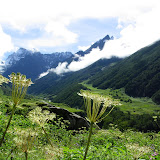 |
| Valley of Flowers |
Pk's pics
 |
| Valley of Flowers |
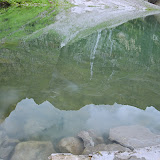 |
| Hemkunt Sahib |
































